Mark Sisson's Blog, page 101
July 10, 2019
8 Tips For Keto on a Budget
 A criticism often leveled against the keto diet is that it’s more expensive than a “regular” (read: SAD) diet. There’s some truth to that. It does cost more to buy meat than ramen and beans. I personally spend more on groceries now than I did before finding Primal. Not only did I shift to buying different types of food, I also came to care more about food quality. I started choosing more pasture-raised meat and eggs, and more pesticide-free and organic produce and dairy.
A criticism often leveled against the keto diet is that it’s more expensive than a “regular” (read: SAD) diet. There’s some truth to that. It does cost more to buy meat than ramen and beans. I personally spend more on groceries now than I did before finding Primal. Not only did I shift to buying different types of food, I also came to care more about food quality. I started choosing more pasture-raised meat and eggs, and more pesticide-free and organic produce and dairy.
However, my grocery bills haven’t changed noticeably since going keto. If you’re already eating Primally, your daily foods don’t have to change that much if you decide to try keto. You’ll remove some (okay, most) of the fruits and root veggies, and sub in more above-ground veggies and probably some healthy fats. It’s not a substantial overhaul. However, if you’re coming from a standard high-carb, lots-of-cheap-packaged-foods diet straight into Primal+keto, it can be a shock to the wallet.
Sure, I can tell you that this is an investment in your long-term health and spending more on food now means spending less on medical care later. I believe that. I also know that doesn’t help you today if you’re looking at your food budget and your fridge, now mostly empty after purging it of non-Primal, higher-carb foods.
If you’re committed to making Primal+keto work on limited funds, it can be done. Here are some tips for making it happen.
1) Buy What You Can Afford
With Primal+keto, there are ideals when it comes to food quality, and then there’s what fits your budget. Now is the time to call on the saying, “Don’t let the perfect be the enemy of the good.” Don’t stress about buying the best quality everything. Don’t forgo eating vegetables because you can’t always fit organic options into your budget. Non-pastured eggs still have more to offer nutrient-wise than a bagel for breakfast.
In terms of priorities, aim for better quality meat. (I’ll include tips for finding less expensive meat choices below.) Check the Monterey Bay Aquarium’s Seafood Watch to see which types of seafood are worth your money and which should be avoided altogether; don’t spend money on the latter.
For produce, check out the Environmental Working Group’s Dirty Dozen—the vegetables and fruits they recommend buying organic—and the Clean Fifteen that are safer to buy conventional. Of note to keto eaters, spinach and kale should be organic, but many of our keto-friendly faves make the clean list. Don’t stress if you need to choose conventional avocados, cauliflower, and broccoli.
Remember, too, that it’s not always necessary to look for the organic label even for the “dirty dozen.” If you’re buying from local farmers, ask about their practices. Many small farmers are pesticide-free or use organic practices but simply can’t afford the process of becoming organic certified (it’s quite expensive and arduous). The same goes for meat.
2) Don’t Menu Plan
I’m going against the grain here. Most articles on budgeting tell you to make and stick to a strict plan. I find, however, that it’s more cost-effective to let sales be my guide. I’d rather check out my local grocery stores and farmer’s markets, buy what’s cheapest, and make it work. Use apps that tell you where the sales are and buy accordingly. Sign up for the customer loyalty cards at the stores you frequent so they can send you deals and coupons.
I realize that this might sound stressful if you don’t feel confident in the kitchen. If you’re beholden to recipes, this doesn’t always work. (Of course, you can always look up recipes on your phone in the grocery store—I’ve done it a million times.) Remember that you can always default to making a Big-Ass Salad or an omelet or scramble.
3) Shop Around
Get to know the various supermarkets, specialty stores, and farmer’s markets in your area. Learn what’s the freshest, cheapest, and most likely to be available at each. While it’s convenient to do one-stop shopping, it might be worth the extra time it takes to make two or three different trips during the week to hit up different stores.
Think outside the traditional grocery store box. In many smaller communities, a “big box” store may have the largest selection of meat and veggies, including organic, and a wide variety of specialty products. In my town, Grocery Outlet is the best place to buy organic coconut oil and olive oil, and they carry lots of other keto-friendly staples like nut butters, grass-fed meat, and cheese at low prices.
If you have access to a farmer’s market, definitely make sure you check it out. Sometimes farmers will mark down their remaining items at the end of the day so they don’t have to pack it up. You won’t have the same selection, but you might score some deals.
Also look into local CSAs, farm stands, and meat purveyors who sell direct to customers. Again, you can often find ones that offer sustainable practices and high-quality products without the expensive organic label. Check out Eat Wild and Local Harvest to find farmers near you. I’m a fan of CSAs that sell “ugly produce”—the items that aren’t pretty enough for grocery stores but that are still tasty and nutritious—so it doesn’t go to waste.
Finally, check Facebook marketplace, Craigslist, and so on for people looking to sell backyard eggs for cheaper than the store. If you live in an area where people hunt, you might be able to score some meat this way during hunting season, too.
4) Skip the MCT Oil and Exogenous Ketone Products
Unless you have a medical reason to have very elevated ketones, these expensive products aren’t a priority. You don’t need them to do keto “right.”
5) Reconsider the Keto-fied Baking
Almond flour, coconut flour, arrowroot powder, erythritol, and so on can also be pricey. From a nutrient perspective, there are better ways to invest your grocery dollars. You don’t have to give it up entirely, but consider how big a chunk it’s taking out of your budget and whether it’s worth it.
6) Eat the Stuff that Other People Don’t Want
I’m talking organ meat, bone-in chicken thighs and drumsticks, sardines, and the like. The great irony is that these are some of the most nutrient-packed foods in the store, and you can often get them for cheap because the average consumer is looking for boneless, skinless chicken breasts. Good news for you!
Ask the butcher at your grocery store if they have organ meats or cuts that they aren’t going to put in the case because they aren’t popular enough. You might be able to snag cheap (or even free) bones for bone broth that way too—although probably less so now that bone broth has become such a trendy item.
If you’re squeamish about organ meat, remember that almost anything can be ground up in a food processor and mixed with ground beef for burgers or meatballs, or to be hidden in chili or meat sauce. Heart is an excellent place to start. It doesn’t have the distinctive strong flavor of liver or kidney, and it’s very affordable.
7) Your Freezer is Your Friend
Many items are less expensive if you buy them frozen—vegetables (especially off-season), berries, seafood—and they’re just as nutritious. Freezing also allows you to buy in bulk and freeze the extras, or prepare big batches of food and freeze smaller portions for later. If you have a chest freezer, look into splitting a cow or a pig with friends. This can sometimes land you a great deal on a pasture-raised animal.
Throwing away food is throwing away money. There’s no reason to waste food if you have a freezer. Most leftovers can be frozen if you’re not going to consume them immediately (though some things, like mashed cauliflower, don’t reheat well). If your avocados are on the verge of going bad, slice and freeze them. Blend fresh herbs with your oil of choice and freeze them in ice cube trays to add to soups and sauces later. Strain leftover bacon grease into a jar and freeze that, too.
My favorite freezer trick is to keep a large zip-top bag to which I add vegetable trimmings like the ends of carrots, celery, onions, and beets, and broccoli stems. I also keep the bones from all the delicious bone-in meat I’m cooking. (I always buy bone-in when I can—it’s one of Dr. Cate Shanahan’s Four Pillars of health.) This allows me to…
8) Make Your Own Bone Broth (and Nut Milk)
Bone broth is a hot commodity nowadays—no pun intended—and you can spend a pretty penny on it at the store… or you can just make it yourself out of stuff that other people are throwing away.
Whenever I cook a whole chicken (which is usually more cost-effective than buying just breasts or thighs), or when my aforementioned freezer bags fill up, I make a batch of bone broth in my slow cooker or Instant Pot. To store it, I freeze it in mason jars or silicone muffin cups. The latter makes broth “pucks” that are uber convenient for adding to dishes later.
Nut milk isn’t necessary for keto obviously. However, if you’re dairy-free and buying nut milk, you really have to try making your own. It couldn’t be easier, and I strongly prefer my homemade nut milk (a blend of almond, hazelnut, and Brazil nut) to anything I can find in the store. As a bonus, I use the leftover nut pulp to make pancakes, bread, and rolls. (See the recipe in The Keto Reset Diet.) It’s a double bang for my buck, and no waste.
The Good News…
Despite the naysaying, it’s not only possible to do keto on a budget, but sometimes going keto actually saves you money. First, many people are able to reduce or eliminate certain medications—insulin, blood pressure meds—which can be a significant monthly savings. Second, once you’ve become keto-adapted, you might find that you’re eating fewer calories overall for the same amount of energy. Mark touts this benefit all the time.
Also, your “non-essentials” budget usually goes down. I’m talking things like frappuccinos, restaurant desserts, and alcohol. The cost of a night on the town decreases significantly when you’re fully buzzed off a glass and a half of wine once you go keto! (And when you’re not ordering 2 a.m. pizza.)
So, let me turn it over to you: Do you have other tips for making Primal+keto easier on the wallet? Share them below, and have a great week, everybody.

The post 8 Tips For Keto on a Budget appeared first on Mark's Daily Apple.



July 9, 2019
The 5 Best Adaptogens for Stress Reduction
 Dr. Jason Fung is stopping by the blog today to share a bit about using adaptogens for stress. Enjoy, everybody—and be sure to share any questions you have on the comment board.
Dr. Jason Fung is stopping by the blog today to share a bit about using adaptogens for stress. Enjoy, everybody—and be sure to share any questions you have on the comment board.
“Adaptogens.” Something about the word is reminiscent of Transformers—you know, those robots that look like a normal automobile or airplane—and then turn into something so much more powerful.
In truth, adaptogens aren’t that different from Transformers. They look like normal herbs, roots, and mushrooms. You’ll perhaps even recognize some of the adaptogens discussed in this article and will have eaten them before.
But adaptogens aren’t just normal plants and mushrooms. Research tells us that adaptogens can transform us into people who are less affected by stress.(1)
And, in the modern world, being less stressed certainly sounds like a superpower, right?
So, let’s take a research-based look at how adaptogens work and which ones you might try. We’ll focus in particular on the best adaptogens for stress reduction.
How It Works: Taking Adaptogens for Stress Reduction
It could be that you’re physically stressed from exercise, worn out from fighting off an illness, or emotionally stressed by a work-life balance issue. In any of these situations, adaptogens can help reduce cortisol levels, balance your hormones, and leave you feeling calmer.
In short, adaptogens help with stress reduction because they increase your tolerance for stress.
The reason adaptogens can assist with a broad range of stressors has to do with the mechanism by which they reduce stress. Rather than going to the specific site of our stress—an injured body part or rush hour traffic (wouldn’t that be nice?)—they go to work on our hypothalamus, pituitary, and adrenal glands. These are the parts of our anatomy that signal and respond to stress.
As a result of this interaction, our “fight or flight” response is less likely to be triggered by every little thing that is happening in our day. And our overall cortisol levels are less likely to skyrocket in response to modern-day stresses that don’t actually deserve a physical response (back to that rush hour traffic).
Conversely, chronically high stress levels—and chronically high cortisol—can lead to adrenal fatigue, digestive issues, and even premature aging. So, the fact that adaptogens can reduce stress is important on a physical level, not just an emotional one. Reducing stress can keep us younger and healthier.
5 Adaptogens That Will Help You with Stress Reduction
So, how do you go about incorporating adaptogens into your diet or supplement regimen? It’s actually pretty easy, and you will recognize some of the names of the adaptogens below. While all adaptogens will reduce your body’s stress response, they each have their own special qualities and methods for attacking stress.
Let’s discuss five adaptogens that you can easily get ahold of and why they might be a great addition to your daily health routine.
1. Chaga Mushroom
Chaga comes first in this list because of its broad spectrum of benefits. Chaga has been used for hundreds of years in a variety of Eastern European countries and may even have been used as far back as Roman times.
It is extremely high in antioxidants and is therefore known for its anti-aging properties. These same antioxidants may be behind chaga’s traditional use as a cancer treatment, as well.(2)
But chaga’s ability to boost the immune system (3) also means it has the benefit of stress reduction. How many of us have experienced the two-fronted attack of stress and illness? Don’t you always come down with the flu or a cold at the worst possible time? A 2011 study demonstrated that mice treated with chaga had an increased ability to fend off viruses and bacteria.(4)
2. Ginseng
This knobby looking root is one of the adaptogens you’re more likely to already be familiar with. Ginseng has trended in and out of fashion in the Western world, but in Traditional Chinese Medicine it has long been a powerful tool for reducing stress, anxiety, and mental fatigue.
There are many recent studies available that demonstrate ginseng’s status as one of the powerful adaptogens for stress reduction. Here are just a few:
A 2003 study on rats found ginseng to be an effective strategy against chronic stress.(5)
A 2010 study on a group of thirty human volunteers showed ginseng improved calmness.(6)
A 2013 meta-analysis of both human and animal studies found ginseng to be an effective “actoprotector,” which means it can increase mental and physical performance. The meta-analysis authors suggested ginseng deserved further research regarding its ability to influence mental work capacity.(7)
Note: because ginseng can also be a natural energy-booster, it can be an effective way to kick a caffeine habit and switch to something more beneficial.
3. Reishi Mushroom
Reishi mushrooms have been used therapeutically for over two thousand years because of the multitude of benefits this mushroom imparts.
In China, reishi mushrooms are considered to symbolize “success, well-being, divine power, and longevity.” (8) On a more practical level, reishi mushrooms are a good source of all nine essential amino acids. (9) This means reishi can assist with muscle growth and recovery, hormonal balance, antibody production, and more—all things that can help us recover from stress and fight it off to begin with.
Reishi has also proven effective in fighting fatigue from various sources. A 2005 study conducted on neurasthenia sufferers—a condition that results in chronic fatigue, irritability, headaches, and more—found consuming reishi resulted in a significant improvement in their symptoms. (10) Another human study found reishi reduced fatigue and improved quality of life in breast cancer patients. (11)
4. Rhodiola Rosea
The adaptogens in rhodiola come from the roots of the plant. Rhodiola is good both for regulating mood and improving cognitive function.
A 2008 study published in the Journal of Alternative and Complementary Medicine demonstrated that participants experienced a significant improvement in their generalized anxiety disorder. (12) And a 2009 study from the Journal of Ethnopharmacology (conducted in a laboratory and using neither humans nor animals) showed that rhodiola roots possessed “potent anti-depressant activity” due to its ability as an MAO inhibitor. (13)
For the most effectiveness, take rhodiola first thing in the morning before you eat.
5. Ashwagandha
While this root has long been prescribed in India for a wide range of issues—everything from inflammation to insomnia—modern science does indeed back up ashwagandha’s claims to positively impact our stress level.
According to a study published in the Indian Journal of Psychological Medicine, study participants’ serum cortisol levels were “substantially reduced.” (14) In this study, participants took 300 mg of high-concentration full-spectrum ashwagandha extract twice a day for sixty days.
Conclusion
As you can see from the diversity of the research, adaptogens are not a simple substance—but their benefits are simple to understand. By improving our immune system, reducing our cortisol, boosting our brain function, and reducing our anxiety, these seemingly “normal” herbs, roots, and mushrooms can drastically reduce our everyday stress levels.
An easy (and delicious) way to give adaptogens a try in your life is with Pique’s TCM Elixirs:
The Chaga Energy Elixir is a perfect way to begin your day. Blended with N.American ginseng and burdock root, it boosts brain function and energy—and is a great alternative to caffeine. (Or you can add it to your coffee or tea, if you’d like!)
The Reishi Calm Elixir is a great way to complete your day. Drinking it in the evenings can help you wind down from work while it also supports your immune system, combats stress, and regulates your mood.
No matter which adaptogens for stress reduction you decide to try, get ready to feel less anxious and more balanced. Both science and traditional medicines tell us this is true. It’s amazing how many benefits such a simple substance can bring to our lives.
Thanks again to Dr. Jason Fung for his post today. Questions about adaptogens for stress management? Share them below. Have a great week, everybody.
References:
1. https://www.ncbi.nlm.nih.gov/pmc/arti...
2. https://www.ncbi.nlm.nih.gov/pubmed/1...
3. https://www.ncbi.nlm.nih.gov/pubmed/1...
4. https://www.ncbi.nlm.nih.gov/pubmed/2...
5. https://www.jstage.jst.go.jp/article/...
6. https://www.ncbi.nlm.nih.gov/pubmed/2...
7. https://www.ncbi.nlm.nih.gov/pmc/arti...
8. https://www.ncbi.nlm.nih.gov/books/NB...
9. https://www.ncbi.nlm.nih.gov/pmc/arti...
10. https://www.ncbi.nlm.nih.gov/pubmed/1...
11. https://www.ncbi.nlm.nih.gov/pubmed/2...
12. https://www.ncbi.nlm.nih.gov/pubmed/1...
13. https://www.ncbi.nlm.nih.gov/pubmed/1...
14. https://www.ncbi.nlm.nih.gov/pmc/arti...

The post The 5 Best Adaptogens for Stress Reduction appeared first on Mark's Daily Apple.



July 8, 2019
Primal+Keto Cooking Made Easy: Sesame Ginger Broccoli
 Anyone who knows me well has seen how much broccoli I eat. It’s one of my go-to sides with chicken or steak at dinnertime. But that doesn’t mean I eat it the same way every day. While roasting is my favorite prep method for broccoli’s flavor, it’s all about the sauces and seasonings, too. One of my favorite ways to punch up broccoli: a sesame ginger flavor. Check it out.
Anyone who knows me well has seen how much broccoli I eat. It’s one of my go-to sides with chicken or steak at dinnertime. But that doesn’t mean I eat it the same way every day. While roasting is my favorite prep method for broccoli’s flavor, it’s all about the sauces and seasonings, too. One of my favorite ways to punch up broccoli: a sesame ginger flavor. Check it out.
Sesame Ginger Broccoli
Servings: 2
Prep Time: 2 minutes
Cook Time: 20 minutes
Ingredients:
1 large head of broccoli (use florets)
1/4 cup Primal Kitchen® Avocado Oil
1/3 cup Primal Kitchen Sesame Ginger Dressing
Instructions:
Preheat oven to 425 ºF.
Place broccoli on a sheet pan. Toss with avocado oil and Sesame Ginger Dressing. Roast for 20-25 minutes, or until lightly browned. Enjoy!
Nutritional Information (per serving):
Calories: 275
Carbs: 6 grams
Net Carbs: 4 grams
Fat: 27 grams
Protein: 2.5 grams

The post Primal+Keto Cooking Made Easy: Sesame Ginger Broccoli appeared first on Mark's Daily Apple.



July 7, 2019
Summer Ratatouille
 As we head into midsummer, we’re already enjoying the first early harvests. This summer ratatouille is the perfect choice for showcasing and enjoying the very best of the summer season’s produce.
As we head into midsummer, we’re already enjoying the first early harvests. This summer ratatouille is the perfect choice for showcasing and enjoying the very best of the summer season’s produce.
Whether you’re serving it as a savory vegan and vegetarian main course or as a generous side dish for some backyard barbecue, this dish is sure to impress all your guests.
Servings: 4
Prep Time: 30 minutes
Cooking Time: 80 minutes
Notes: The ingredients are broken down by type of vegetable for easy arranging later on, but you can cut down on bowls and prep by combining the zucchini and squash/bell pepper ingredients together. Allowing the eggplant to marinate separately ensures the slices stay moist and flavorful while cooking. You can also experiment with different herbs and herb blends with this dish, including basil, rosemary, herbs de provence, etc. Your options are endless! The vegetables are arranged in an oven-safe dish and covered with aluminum foil prior to baking. If you’d like to avoid foil, make this dish in a lightly greased dutch oven and cover it with a lid instead.
Ingredients:

Eggplant mix:
2 cups sliced eggplant
1 1/2 Tbsp. Primal Kitchen® Balsamic Vinaigrette and Marinade
1 1/2 Tbsp. Primal Kitchen Extra Virgin Avocado Oil
1 Tbsp. olive oil
1 tsp. chopped thyme
1 clove garlic, chopped
Pinch of salt
Zucchini mix:
2.5 cups sliced zucchini
1 Tbsp. Primal Kitchen Extra Virgin Avocado Oil
1 Tbsp. chopped parsley
1 tsp. chopped thyme
1 clove garlic, chopped
Pinch of salt and pepper
Squash mix:
1 1/2 cups sliced yellow squash
½ cup sliced and halved red bell pepper
1 Tbsp. olive oil
1 Tbsp. chopped parsley
1 clove garlic, minced
Tomato and shallot mix:
3/4 cup sliced shallots
3/4 cup halved cherry tomatoes
1 1/2 Tbsp. Primal Kitchen Balsamic Vinaigrette and Marinade
1 tsp. basil
1 tsp. chopped thyme
1 clove garlic, minced
Pinch of salt
Garnish: parsley and thyme
Instructions:
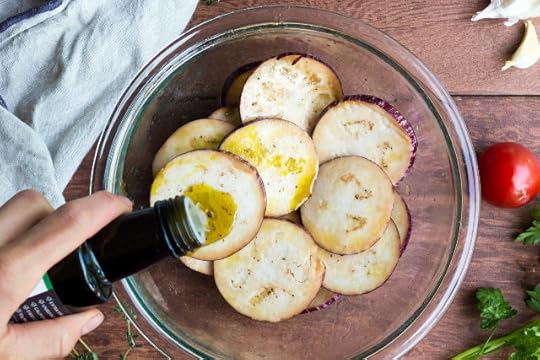
Combine the eggplant ingredients in a bowl and toss until all of the slices are well coated. Set aside and marinate for 30 minutes.
Combine the shallot ingredients in another bowl and allow the tomatoes and shallots to marinate for 30 minutes.
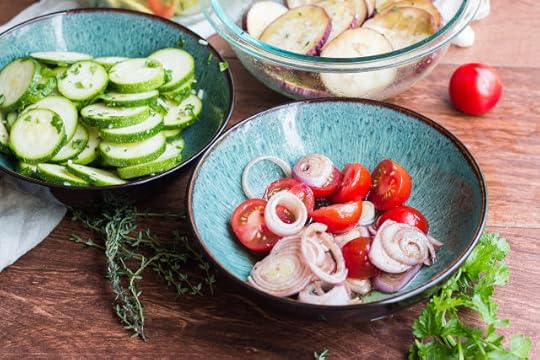
Toss the sliced zucchini ingredients in a bowl.
Toss the squash and pepper ingredients in another bowl.
Preheat your oven to 350 ºF. Grease a square or round baking dish or small dutch oven with a little olive or avocado oil.

Carefully arrange the eggplant, zucchini, and squash rounds and red pepper slices in an alternating pattern around the dish, being sure to arrange them so the rounds are perpendicular to the bottom of the dish. Continue arranging the slices; you can work from the inside out or the outside in depending on what’s easiest to you. Continue until the dish is either very full or you run out of vegetables. If you have some slices left over, you can push some slices aside to make room for the remaining slices.
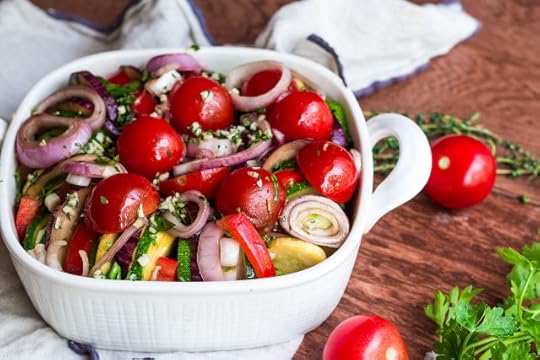
Top the dish with the shallot and tomato mixture, drizzling all of the liquid from the bowl around the dish. Tightly cover the dish with foil or pop the lid on if you are using a dutch oven. Place the ratatouille in the oven for 45-50 minutes.
Remove the foil/lid to check to see if the vegetables are just tender. If the vegetables aren’t tender, you can place the dish back in the oven for another 15-20 minutes. Uncover the dish and place it back in the oven for an additional 20 minutes. Sprinkle with salt and pepper and garnish with extra thyme and parsley.
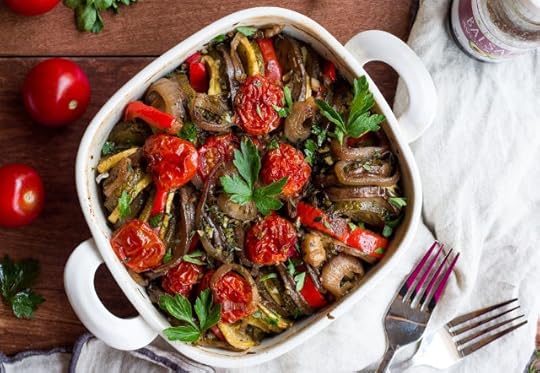
Nutrition Information (¼ of ratatouille):
Calories: 242
Total Carbs: 12 grams
Net Carbs: 8 grams
Fat: 22 grams
Protein: 3 grams

The post Summer Ratatouille appeared first on Mark's Daily Apple.



July 5, 2019
Weekly Link Love — Edition 36

Research of the Week
Agriculture (and increased availability of carbohydrates) increased the frequency of genes controlling blood sugar. People with the ancestral version of the gene have an easier time maintaining blood sugar while fasting but tend to have more trouble controlling blood sugar after carb consumption.
For the first time ever, scientists directly observe the transfer of RNA from an animal’s brain to its sperm and onto its offspring. Is this the mechanism for transgenerational inheritance?
Trigger warnings don’t actually help students reduce stress or learn any better but they make students believe in their efficacy.
Pesticide exposure linked to increased depression in teens.
We once walked with (or ran from…or ate) birds as big as elephants.
New Primal Blueprint Podcasts

Episode 353: Endurance: Brock Armstrong: Host Brad Kearns talks with frequent guest Brock Armstrong about synching endurance training and goals with quality of life and losing fat the healthy way.

Episode 354: Oren Jay Sofer: Host Elle Russ chats with Oren Jay Sofer about nonviolent, mindful communication.

Primal Health Coach Radio, Episode 17: Laura and Erin talk with Rachel Bell about building your empire.
Each week, select Mark’s Daily Apple blog posts are prepared as Primal Blueprint Podcasts. Need to catch up on reading, but don’t have the time? Prefer to listen to articles while on the go? Check out the new blog post podcasts below, and subscribe to the Primal Blueprint Podcast here so you never miss an episode.
Media, Schmedia
How has legal cannabis gone in Colorado (NY Times link)?
Obesity takes the lead.
Interesting Blog Posts
Debunking top keto myths is a lot easier (and more convincing) when you have 150,000 days of patient care to draw upon.
Is Dean Ornish’s lifestyle program actually proven to reverse heart disease?
Social Notes
Everything Else
Primal Jellyfish Collagen coming Spring of 2020.
There’s really no good metaphor for the human microbiome.
The Pentagon has a laser that can identify people by their heartbeat.
Things I’m Up to and Interested In
I’m not sure what to think about this: The Water Bar opens in DC, featuring a $25 bottle of water, among others.
Article I found interesting: How a man’s biology changes after becoming a father (NY Times).
I feel like I read a similar story every few months: There’s a new tick in the US.
Some cool concepts here (gluten warning): What you can learn from Norwegian packed lunches.
This is a powerful story: A boy had a rare genetic lymphatic disorder. Doctors inserted the relevant genetic mutation into 10 sets of zebrafish, tested different drugs in each set, and gave the one that worked to the boy. It worked in him too.
Question I’m Asking
Read the Norwegian packed lunch article from above. Can you come up with a similar concept for no-frills, easy-prep, near zero-cleanup Primal or keto lunches?
Recipe Corner
Truly caramelized onions.
Pizza burgers? Pizza burgers.
Time Capsule
One year ago (Jun 30– Jul 6)
What is Paleo? – Well, what is it?
Does “Sleep Hacking” Work? – Can you cheat your sleep?
Comment of the Week
“Like most of us, I sometimes procrastinate for what seems to be no good reason. However, I’ve found two categories of procrastination that actually make me more productive.
With the first type of deliberate procrastination, I will put something off to allow for ‘subconscious fermentation.’ I find this very useful for certain tasks that involve problem solving that I am highly motivated to get done right away, but backing off for a day or two improves my effectiveness at tackling the task. For example, I had very large limb from a tree on my property break in a wind storm and get hung up in another tree with both ends suspended ten-plus feet off the ground. My first instinct was to deal with it right away. That meant either calling a professional and paying several hundred dollars or climbing up a tall ladder and wielding a chainsaw at a height that seemed precarious—neither of these options was particularly attractive to me, but something had to be done. I so badly wanted to get moving on this the day it happened, but I forced myself to procrastinate to allow my mind to work on the problem in the background. Two days later inspiration struck: I threw a rope over the limb, tied a large trash can to the rope and hoisted it several feet in the air, tied it off, put a garden hose in the trash can, turned it on, stepped back, and let the gradually increasing weight of the water-filled can safely pull the limb out of the trees and to the ground. Thank you, procrastination!
The second type of planned procrastination I use is for completing simple tasks I don’t care for that I have a tendency to do inefficiently and/or lament over if I give myself plenty of time. Put another way, some tasks become less unpleasant when I use procrastination to force a sense of urgency. For me, packing for a trip is a good example. I find if I decide to wait almost until the last minute (critical to this is giving myself a reasonable window of time), I’m forced to be highly focused in getting all my stuff together and the work becomes much more enjoyable and I spend my time more effectively.
With both of the above types of procrastination, I find I need to make a deliberate decision to delay. For the first type, it allows for more effective solutions to complex tasks. For the second type, it helps me to be more efficient and avoid the unease of anticipating doing a task I otherwise find monotonous or distasteful.”
– I love “subconscious fermentation,” Jim.

The post Weekly Link Love — Edition 36 appeared first on Mark's Daily Apple.



July 4, 2019
Dear Mark: Why No Soy in PK Teriyaki, What Slackline to Buy, and Type 2 Diabetics and Keto
 For today’s edition of Dear Mark, I’m answering three questions.
For today’s edition of Dear Mark, I’m answering three questions.
First, why did I leave out soy sauce from the Primal Kitchen® No Soy Teriyaki Sauce? Second, what slackline do I recommend beginners buy? And third, is keto safe for people with type 2 diabetes?
Let’s find out:
Hey Mark,
How come you didn’t use soy sauce in the new teriyaki?
The response to our new Primal Kitchen No Soy Teriyaki sauce has been overwhelmingly positive. I can’t blame them. The stuff is delicious. But, like you, a few have wondered why we decided to omit the soy. After all, the soy in traditional teriyaki sauce is soy sauce—a fermented product—and I’ve spoken positively about fermented soy in the past. I support the consumption of natto, a fermented soybean product with the highest vitamin K2 density of any food out there. Miso’s pretty good. Even tempeh is better than un-fermented soy. And traditional soy sauce fermentation is so thorough that several different gluten assays are unable to detect any gluten present in the finished product, despite wheat being a vital ingredient. Why not include actual soy sauce, or at least tamari (wheat-free soy sauce), in the PK teriyaki?
First of all, I make this stuff for you guys. For the people who’ve been there from the beginning. For the people who got into this Primal/paleo stuff because they had unexplained rashes, weird weight gain, gut issues, even though they were eating the conventionally “healthy” diet. And many of you (as many of you have told me over the years) have figured out that you have intolerance issues with soy—even if it’s fermented to high heaven. The last thing I want to do is exacerbate an autoimmune issue, especially if the ingredient in question isn’t actually necessary.
And two, I knew I could make something delicious and unique without soy. I didn’t need it. Maybe it’s not exactly like teriyaki sauce you’ve known and loved. For one thing, it has far less sugar. But it’s really, really good. It serves the same purpose as teriyaki sauce. It even manages to give the appearance of sweetness (at least, if your taste buds haven’t been deadened by decades of sugar baths) without actually having any added sugar—just balsamic vinegar. Soy simply wasn’t necessary.
Believe me: we tried different formulas that included soy sauce. They were fine, sure, but they weren’t necessary to get the result we wanted. And so we left it out. Why not leave out a potential allergen, one that a disproportionate number of our customers seem sensitive to? It was a no-brainer.
There are plenty of decent teriyaki sauces out there (although you might have to whip it up yourself to limit the sugar). Ours is just unique.
I definitely feel that procrastination is a mechanism of self-defense. After a long day of “mental work”, when I come home it’s not that “I’m tired” is more “I need to decompress”. One of my go-to phrases: “I’ll do it in the morning”. I still haven’t gotten myself one of those slacklines… is there a particular one you recommend?
I’ve always loved the Gibbon slacklines. The basic one is more than enough for most people.
A few beginner tips I always give to newcomers:
Focus on standing on one leg. Get comfortable there. Then spend even more time on one leg before trying to take steps.
Use trekking or ski poles to get comfortable. If you aren’t making any progress at all, there’s no shame in using a little assistance.
Know that the line won’t swing out from under you when you take a step. It feels like it will, but it won’t. Trust and have faith (kinda like life).
Let your arms swing where they may. Keep them fluid (like a gibbon), not rigid.
Whatever you do, don’t get discouraged. The first couple hours on a slackline is really humbling for almost everyone. I have a long history of board and “balance” sports (snowboarding, standup paddling, etc), and my first time on the slackline I could barely stand up. Your leg will wiggle more than you ever thought possible. Keep going. Even though it won’t feel like you’re making progress, you are. Your brain is taking notes, drawing new paths between neurons. It’s learning. Giving up gives your brain the message that this task is too difficult for you, and it’ll stop learning.
Is Keto dieting ok for us type II diabetics?
Most signs point to “yes.”
Type 2 diabetes has been described as a disease of carbohydrate intolerance. If that’s true, then removing or severely restricting the thing you’re intolerant of seems logical. What happens when you do that?
Very recently, a large study came out that supports the use of keto in this population. Two groups of type 2 diabetics were placed either on a very low carb ketogenic diet or a standard diet for two years. The ketogenic group:
Lowered their HbA1c.
Reduced their diabetes medication usage.
Lost visceral body fat.
The control group experienced none of these benefits.
Furthermore, 55% of the keto group reversed their diabetes and 18% went into remission.
I’ve heard some people make the point that because keto doesn’t necessarily give a type 2 diabetic the ability to eat a big baked potato and have normal blood glucose, it’s not actually a “cure.” Maybe. But would you say the same thing to an alcoholic who no longer drinks? Is sobriety not a viable treatment for alcoholism because if the alcoholic took a drink he’d fall off the wagon? No. That’s ridiculous.
That’s it for today, folks. Happy 4th to all my U.S. readers out there. Enjoy a safe and healthy holiday weekend.

References:
Cao W, Watson D, Bakke M, et al. Detection of Gluten during the Fermentation Process To Produce Soy Sauce. J Food Prot. 2017;:799-808.
Athinarayanan SJ, Adams RN, Hallberg SJ, et al. Long-Term Effects of a Novel Continuous Remote Care Intervention Including Nutritional Ketosis for the Management of Type 2 Diabetes: A 2-Year Non-randomized Clinical Trial. Front Endocrinol (Lausanne). 2019;10:348.
The post Dear Mark: Why No Soy in PK Teriyaki, What Slackline to Buy, and Type 2 Diabetics and Keto appeared first on Mark's Daily Apple.



July 3, 2019
7 Foods Keto Eaters Shouldn’t Fear
 I don’t like being told what to do. That’s why I’m not a fan of hard and fast food rules, as I’ve written before. Don’t get me wrong, that doesn’t mean I believe all foods are created equal. There are foods that aren’t health-promoting in any context. (I’m looking at you, processed chemical nacho cheese-like sauce.) Nevertheless, I’m incredulous when people suggest that they’re not “allowed” to eat certain foods on a Primal or keto diet.
I don’t like being told what to do. That’s why I’m not a fan of hard and fast food rules, as I’ve written before. Don’t get me wrong, that doesn’t mean I believe all foods are created equal. There are foods that aren’t health-promoting in any context. (I’m looking at you, processed chemical nacho cheese-like sauce.) Nevertheless, I’m incredulous when people suggest that they’re not “allowed” to eat certain foods on a Primal or keto diet.
Sure, we Primal folks choose to center our diets around the foods in the Primal Blueprint Food Pyramid. And once you go keto, higher-carb foods—even nutrient-dense ones—are harder to fit into your daily macros if staying in ketosis is important to you. However, I’ve found that keto people are overly prone to policing one another’s food choices based on their notions of keto.
Context is important. As a metabolically healthy person, I recognize that I have the luxury of eating more carbs than someone who’s insulin resistant and who struggles to regulate blood glucose. I also have the freedom to move in and out of ketosis in a way that someone doing a therapeutic keto diet might not.
Depending on your circumstances, the “rules” of keto might be different for you than they are for me. My beef is with people who insist that everyone adhere to the strictest possible version of keto no matter the context or who villainize “carbs” as if that’s a discrete food group. Different foods provide different benefits, so I prefer to incorporate as many types of food as I can within reason. Plus, variety helps me enjoy my diet more.
I don’t want to exclude foods just because they don’t work for someone else—or because of some arbitrary notion that they “aren’t keto.” In fact, here’s a list of foods that people have genuinely told me I’m not allowed to eat on keto, presumably because they’re too high-carb. (And, yes, I eat all these foods even when I’m keto.)
Disclaimer: Of course, I’m not suggesting that you have to eat these just because I do. This is simply a reminder that you don’t have to listen to the keto police. You can and should find a way of eating that suits you personally.
(Note: the carb counts are from Cron-o-meter and reflect the servings I’m used to eating while keto.)
1) Beets
I love beets, so the blame and shame around beets while keto makes me shake my head. Sure, as a root they’re higher in carbs than above-ground veggies. The ½ cup of cubed cooked beets I add to my Big-Ass Salad comes in at 8 grams of carbs.
To me, that’s not bad, especially weighed against the health benefits of beets. They happen to be a fantastic source of folate, manganese, potassium, and other nutrients. The betalain found in beets has been studied extensively as an anti-inflammatory, antioxidant compound with a variety of potential medical applications. Beets are also rich in nitrates, which can be cardioprotective, improve blood flow to the brain, and—of particular interest to me—improve cardiorespiratory endurance in athletes. (Although research focuses mostly on beetroot juice or concentrate, eating whole beets appears to work, too.)
I’ll keeping my beets, along with the greens.
2) Berries
You’ll see a lot of soapbox rants on keto boards decrying berries, which is surprising because berries are GRAOKFK (generally regarded as O.K. for keto). Nonetheless, there are plenty of people out there proclaiming that blueberries are too high-carb for keto. I’ve also seen people argue that only blueberries are allowed (presumably because they’re a “superfood”—more on that in a moment).
Take a look at the carbohydrates in these common berries:
Blueberries (1/3 cup ): 7 grams
Blackberries (1/3 cup): 5 grams
Raspberries (1/3 cup): 5 grams
Strawberries (1/3 cup): 4 grams
As you can see, blueberries actually deliver the most carbs among these options, but their carb count is still pretty modest. Anyway, berries are healthy and delicious. All berries score well on the antioxidant charts, but blackberries and raspberries actually have slightly higher ORAC values than “superfood” blueberries (the blueberry industry must have a better marketing team). Berries also score low on glycemic index (GI) and glycemic load (GL), although blueberries push the middle range of GI.
The bottom line is: if your carb budget is tight, sure, go for strawberries instead of blueberries, but blueberries are hardly a “non-keto” food.
3) Carrots
There’s a running joke in our Keto Reset Facebook group about carrots. Along with beets, carrots tend to be metaphorically slapped out of your hand if you admit to eating them in some of the other online keto groups.
I’ve known keto folks who’ll pick the shredded carrot out of packaged broccoli slaw or restaurant salad mix. The thing is, if you manage to painstakingly pick ¼ cup of shredded carrot from your salad, all the painstaking effort saves you less than 3 grams of carbs. (Not worth it if you ask me.) Even a large whole carrot contains only 7 grams of carbs—and low-GL carbs, at that.
I don’t know where this fear-mongering came from. Perhaps it’s because carrots are a root vegetable, and one of the keto police rules is that root veggies are not keto. While it makes sense that most of your vegetable intake should be in the form of above-ground vegetables, that doesn’t necessitate avoiding every shred (literally) of healthy root vegetables.
4) Cashews
Truth be told, I don’t eat cashews all that often. At 10 grams of carbs in ¼ cup, they are higher carb than any other nuts I eat regularly, and for no special health benefits. Check out my Definitive Guide to Nuts for the lowdown on how different varieties compare.
One application I do appreciate is cashew cream for dairy-free and egg-free recipes such as this one. Personally, I have no problem with dairy, but for people with food sensitivities, this can be a nice option.
5) Grapefruit
I used to have a grapefruit tree in my backyard, and I’ve enjoyed incorporating fresh grapefruit into summer salads now and then. Arugula, shaved fennel, avocado, and grapefruit is a tasty combo.
Caveat: this one is probably the biggest stretch for people who are still struggling with insulin and glucose regulation. Half a small grapefruit—enough for two servings of the aforementioned arugula salad—packs 11 grams of carbs. That said, grapefruit are among the lowest GI and GL fruits, on par with raspberries. If you’re at a place with keto where you’re ready to test your metabolic flexibility and see how you respond to introducing some fruits in moderate quantities, grapefruit might be one to try.
6) Pumpkin
One-quarter cup of homemade cooked pumpkin has 3 grams of carbs (canned unsweetened pumpkin has 5 grams).
So, go ahead and whip up a homemade PSL sweetened with stevia. There’s a recipe in The Keto Reset Diet Cookbook. In fact, you’ll find several pumpkin recipes in there, including directions for making your own puree.
7) Tomatoes
Tomatoes are another one of those “they taste kind of sweet, so they must be bad for keto” foods. Nah. It’s tomato season right now, and I’m enjoying a Caprese salad with cherry tomatoes every single day. The ten cherry tomatoes in my salad have fewer than 7 grams of carbs. A thick slice of tomato on your lettuce-wrapped burger comes in at a whopping 1 gram of carbs.
Keto folks do need to be mindful of the carbs in sugary store-bought ketchup (which is why I created Primal Kitchen® Unsweetened Ketchup). The carbs in a huge plate of zoodles with marinara can definitely add up. As with all the foods on this list, the quantity matters.
Finally, Did I Mention That Context Is Important?
If you’re looking at this list, going, “There’s no way I could allot XX grams of carbs to ____!”, is it because you’re limiting yourself to 20 or 30 grams of carbs per day? If yes, is there a specific reason? The Keto Reset Diet recommends that most people aim for 50 grams of carbs per day, not counting non-starchy vegetables and avocados. (If you’re doing a therapeutic keto diet, or if you’re highly insulin resistant, you might do better starting at 30 grams per day.)
With any of these foods, if you aren’t sure if they work for you, consider experimenting. I’m not a huge proponent of measuring and assessing everything, but in this case it might offer helpful info. Eat the food you want to include, then test your blood glucose and ketones two hours later. For example, if you want to add a handful of blueberries to your Big-Ass Salad, try it and see how your body responds. Of course, this only works if you know your baseline blood glucose and ketones—and if you also know how your body responds to the salad without the blueberries.
Or you don’t have to be that systematic about it. Barring a medical need to be in ketosis all the time, you can go by subjective evaluations of how you feel when you include certain foods.
Finally, if you are working with a limited carb budget and want to expand your vegetable (and even fruit) repertoire, considering targeting your intake of these foods around exercise to blunt the effect.
There you go, folks. Surprises? Additions? Responses? Share your thoughts below, and have a great rest of the week.

The post 7 Foods Keto Eaters Shouldn’t Fear appeared first on Mark's Daily Apple.



July 2, 2019
Diastasis Recti: What To Know
 Today’s post is part two of a postpartum series inspired by a reader question. You can read part one
here
.
Today’s post is part two of a postpartum series inspired by a reader question. You can read part one
here
.
Diastasis recti (DR) is usually described shorthand as a separation of the ab muscles. More accurately, it’s a deformation of the linea alba, the line of connective tissue that runs down the front of your torso from your ribcage to your pelvis. The linea alba is basically where all the abdominal muscles meet in the middle; I think of it like the spine of a book. When the linea alba becomes deformed for reasons I’ll discuss in a moment, the rectus abdominis muscles, aka your “six-pack” muscles, pull apart. This is the (often visible) sign of DR.
More than a cosmetic issue, this compromises the integrity of your core and can be associated with a whole host of other problems if not corrected. Although it’s difficult to establish clear causal relationships, DR is often related to pelvic floor issues and incontinence, back pain, hernias and prolapses, and difficulty exercising. While some DR resolve on their own, often they require intervention—targeted exercises to bring the muscles back together or, in some extreme cases, surgery.
What Causes Diastasis Recti?
To understand DR, you have to understand that the abdominal cavity is always under pressure. Wedged as it is between the thoracic (chest) cavity and the pelvic cavity, the pressure in your abdomen is always shifting based on your breathing, movement, digestion, and so on. If the pressure isn’t too great, it’s no problem. However, when the pressure increases—say perhaps because you have a growing baby taking up more and more space in there—one of the ways that pressure can manifest is by pushing outward on the front of the belly. The linea alba stretches and weakens, and the rectus abdominis ends up abnormally separated.
I say “abnormally” because some separation can be classified as normal, especially during pregnancy, and can simply reflect individual structural differences. Estimates of the prevalence of DR among pregnant women range from 66%-100% of women experiencing some degree of DR by the end of pregnancy. Abdominal separation that does not resolve on its own soon after pregnancy, or DR not associated with pregnancy, needs to be addressed as soon as possible.
That’s right—men, children, and women who have never been pregnant can all have DR. Any conditions that increase intra-abdominal pressure and stretch and weaken the linea alba can lead to DR. These include things like overdoing traditional ab exercises like sit-ups, chronic coughing, and chronic constipation leading to straining. Injury to the linea alba, including from abdominal surgery, is another risk factor.
Renowned biomechanist Katy Bowman believes that alignment (how we hold our bodies throughout the day), movement, and even breathing all play a key role in preventing or developing DR. This isn’t to say that breathing incorrectly will make your abs split apart. Rather, the types of loads we place ourselves under can make us more or less susceptible to developing DR. On the flip side, by fostering proper alignment and movement patterns, you might be able to avoid DR even during and after pregnancy. More on this later.
How Do I Know If I Have Diastasis Recti?
Unfortunately, DR is often overlooked even in the antenatal and postpartum periods. However, it’s easy to test for yourself whether you have DR. The most obvious sign is if your stomach bulges when you do a traditional crunch (don’t do crunches if you think you have DR, or ever really—they aren’t a particularly safe or effective ab exercise), cough, or otherwise load your abs. This might look like a small football in your tummy, a loaf of bread, or just a mound. It is most likely to appear right around your navel, but it can also happen above or below your navel, or all of the above.
Even if it’s not visible, if you have pelvic floor weakness (no ladies, we shouldn’t be peeing when we run or jump rope), chronic back pain, hernias, or even digestive issues like constipation or bloating, you should check yourself for DR. Likewise if you feel like your abs are weak or aren’t holding you in, for lack of a better term, perform a self-test.
To do this, lower yourself carefully onto your back and lie flat with your feet on the floor and your knees bent. Lift up your shirt and slide your waistband down so you can feel your abs from your pubic bone to your sternum. Take two or three fingers and with your palm facing you, press down firmly at the top of your navel while you slowly lift your head off the floor like you’re beginning a crunch. You should feel your rectus abdominis muscles tense on either side of your fingers. Relax your head back to the floor. Repeat this test below your navel and above your navel up to your sternum. (Check out the video here if you need more guidance.)
You are feeling for two things:
What is the gap between the ridges of your muscles? Anything greater than about two finger-widths is considered positive for DR. (The generally accepted medical standard is a gap of 2.7 centimeters.)
How “squishy” is the linea alba? In other words, how far down do your fingers sink when you press? Ideally your linea alba would feel firm and resist being pressed down.
Don’t freak out if your fingers sink down in there! Now you know and can do something about it.
I Have a Diastasis… Now What?
If you believe that you have DR, it’s a good idea to get it checked by a doctor so you can get a referral to a physical therapist if needed. Look for a PT who specializes in DR and, if applicable, postpartum fitness. While surgery is sometimes recommended for serious cases of DR, it’s not to be taken lightly and might be avoidable with the help of a knowledgeable PT. Of course this is a decision that you must make with your doctor. Mild-to-moderate cases are often correctable with simple at-home techniques, but especially if you’re pregnant or have recently delivered your baby, I am still going to advise checking in with your doctor first.
Even if your doctor determines that you don’t meet the medical criteria for diagnosis, the exercises suggested to resolve DR will be helpful for anyone wishing to improve alignment and increase core strength and stability. That’s to say, even if you don’t have significant DR, you’ll likely still benefit from what I call the ABCDs of fixing DR. They are generally regarded as safe during pregnancy to help mitigate the damage of DR, but always talk to your doctor or midwife to be sure.
Alignment
Katy Bowman reminds us that we can’t look at any one body part in isolation. While we might think of DR as a problem in the abdominals, in fact the pelvis, abdominal muscles, and ribs are all connected. Moving any other body part that also moves the pelvis or the ribs will therefore affect the abdominal muscles and connective tissue.
Katy’s book, Diastasis Recti: The Whole-Body Solution to Abdominal Weakness and Separation, is a great resource. She focuses on proper alignment as both a preventative and restorative practice, and then she walks readers through a series of whole-body exercises, starting small and progressing to larger movements, that can improve DR. Her alignment checklist is as follows:
Straighten your feet
Back your hips up
Align your knee pits
Adjust your pelvis
Drop your ribs
Relax your diaphragm
For help understanding what this looks like in practice, I recommend starting with this video. It’s designed for runners, but it demonstrates the same principles that are important here. Katy also provides tons of information and resources on her website, Nutritious Movement. (Start with her Under Pressure post.)
You can’t have proper alignment if you’re walking around in heels all day, unfortunately, so it’s time to embrace going barefoot and wearing minimalist shoes as often as possible. If you’re used to wearing heels or even just traditional shoes (which often have a heel lift that we don’t even notice), make sure you take care to transition to a minimalist/barefoot lifestyle safely.
Breathing
The goal here is diaphragmatic breathing that engages the transverse abdominis (TA) muscles. Quick anatomy lesson: What we call “the abs” are not just the rectus abdominis muscles that make the six-pack. There are actually layers of muscles and connective tissue criss-crossing around in there. The TA are the innermost layer. They wrap all the way around the torso from the spine to the linea alba, and they are often described as looking like a corset.
In order to close a DR, we need to be able to recruit the TA, which means connecting to it and learning to activate it in the first place. This is where diaphragmatic breathing comes in. I find it easiest to feel my TA and understand what diaphragmatic breathing is supposed to feel like when lying on my back, but you can also do this kneeling. Place a hand on your belly and try to breathe into your hand, meaning you should feel a slight expansion of the belly as you breath. You aren’t forcing your belly out, but you want the motion as you inhale to be under your hand, not in your chest.
Next, place your fingers just above your hip bones on either side. Inhale through your belly, then exhale with some force, making a hissing noise. As you exhale, imagine tightening your core so your fingers move toward each other ever so slightly. This is not sucking in your belly, this is engaging that TA that wraps around from your back. Your belly should neither suck in nor pooch out, it should feel like it’s flattening (even if you can’t see it). Another cue my trainer sometimes uses is imagining zipping up the “corset” from the pelvis to the sternum.
Feeling the flexion underneath your fingers can be helpful for knowing you’re doing it right. If you’re having trouble understanding the technique, check out this video for a demonstration. Once you feel really connected to the TA, you can proceed to other strengthening exercises.
Core Exercises—but Only the Right Ones
I’m going to reiterate here that it’s important to consult with your doctor if you are concerned that you have limitations that might make any kind of exercise unsafe or inadvisable for you. In the case of DR, it’s a good idea to find a physical therapist and/or someone trained in DR or postpartum fitness who can help check that you’re doing the alignment and TA activation pieces correctly, and who can advise you on proper core exercises.
That said, there is widespread agreement about what not to do if you have DR, and that is any core exercise that increases intra-abdominal pressure. These include traditional crunches and sit-ups and, yes, planks. I know planks are one of the Primal Essential Movements, but they aren’t for you right now. Likewise experts advise avoiding twisting motions such as Russian twists and even certain yoga poses; high-impact exercises such running; and full-body exercises that require core activation like burpees, push-ups, and pullups (two more Essential Movements bite the dust) and heavy lifting.
Yes, that’s a lot, and it’s a bummer. That means you shouldn’t sign up for a 5k or get back to CrossFit until you take the time to address the DR. Bear in mind, though, that if you can’t properly engage your core during exercise, you’re at significant risk for injury and additional problems down the road. Although you likely have to back-burner some of your favorite activities in the short term, long term it is worth it to fix the DR first.
In order to do so, you need to work on gentle, appropriate exercises to strengthen the entire core. I’m not a PT or personal trainer, so I’m not going to give you specific exercises here. As I mentioned, Katy Bowman’s excellent Diastasis Recti book includes a whole series of progression exercises, and there are many resources and programs available online. You can also check out the movements here, here, and here for examples of the types of exercises that are generally regarded as safe and beneficial for DR. Did I mention you should check with your doctor first and consult a PT if you can? Good. I will also put some additional resources at the bottom of the post.
Diet
Because DR can be thought of as an injury to the connective tissue, you can support recovery by eating a nutrient-rich, anti-inflammatory diet that includes a variety of vegetables, sufficient protein, and essential fatty acids to promote healing. Since this just so happens to describe the Primal way of eating, hopefully you already have this box checked.
Also include plenty of collagen-rich bone broth. Use it in cooking or simply sit on a mug of broth during the day. You can jazz it up by blending in different herbs and spices. My favorite is using my immersion blender to blend 2 teaspoons butter or ghee, ¼ teaspoon turmeric (an anti-inflammatory powerhouse), and a pinch of black pepper into a mug of ghee to make a frothy golden “latte.”
To Splint or Not To Splint?
Experts disagree about whether it’s advisable to wear a splint or brace to support the abdominals while you work on closing your DR. Since there’s no consensus, this is another area where you should consult your doctor or PT about your specific needs.
But When Can I Start the Real Exercise?
If you’ve recently had a baby, you probably miss the physical activities you couldn’t do later in your pregnancy. It’s hard to be patient and do breathing exercises when you really want to be going for a run and hoisting a barbell over your head.
I implore you to be patient. It will pay off in the long run! And please, please don’t push your body too far too soon because you’re feeling pressure to get back to exercise ASAP so you can “get your pre-baby body back.” With proper care, a DR might start to resolve in a matter of weeks, but realistically it might be several months or longer before it is fully fixed.
Only after you have done the foundational work of the ABCDs should you move on to other exercise. Make sure you’re selecting safer movements that don’t put excess stress on the DR. You should ease slowly into more strenuous or vigorous exercise, paying attention to how your body responds. If you can, work with a qualified trainer or coach who can help you determine a safe progression back into your exercise modality of choice.
What If My Post-baby Belly Isn’t DR?
Even if you don’t pass the two finger test, you can benefit from working on alignment as Katy Bowman describes, as well as working on activating the TA, the foundation of a strong and healthy core and pelvic floor. Everyone should be doing these things, really.
If you’ve done all this and still feel like you look bloated or pregnant despite being well into the postpartum period, you might be experiencing bloating due to food sensitivities or gut issues such as imbalances in the microbiome. Talk to your doctor or find a functional medicine practitioner to help you dig into that more. If your issue is an accumulation of fat in the midsection, that can be related to stress and excess cortisol. You can work with your doctor to diagnose this, and/or start working on your own to manage stress.
At the end of the day, you might also have to accept that your body isn’t going to look exactly the same as it did before, and that’s ok. If you’re struggling with that, please check out my previous post on postpartum body image for support.
RESOURCES:
Find a professional to help diagnose and treat your DR:
http://aptaapps.apta.org/findapt (Put in your search area, then select Women’s Health on the following page)
https://fit2b.us/diastasis-directory/
The following offer paid programs designed to fix DR. They are endorsed by a variety of individuals and professional organizations. We at Mark’s Daily Apple do not have personal experience with these programs.
Every Mother (previously The Dia Method)
MUTU System
The Tupler Technique
Do you have experience with diastasis recti or resources related to treatment? Share your thoughts and questions below, and thanks for reading today.

The post Diastasis Recti: What To Know appeared first on Mark's Daily Apple.



July 1, 2019
Primal+Keto Cooking Made Easy: Chimichurri
 Today Lindsay’s here sharing one of her favorite keto-friendly sauces—chimichurri. One of the best ways to keep your keto eating varied and flavorful is to experiment with great tasting sauces. Chimichurri is one the most versatile choices as well as one of the easiest to adapt to you own personal tastes.
Today Lindsay’s here sharing one of her favorite keto-friendly sauces—chimichurri. One of the best ways to keep your keto eating varied and flavorful is to experiment with great tasting sauces. Chimichurri is one the most versatile choices as well as one of the easiest to adapt to you own personal tastes.
In less than five minutes you can have a double batch ready for the week ahead. Enjoy!
??
Chimichurri
Servings: 4
Prep Time: 5 minutes
Cook Time: none
Ingredients:
1/2 cup parsley, chopped
1/4 cup fresh oregano (discard stems)
4 garlic cloves
3 tablespoons red wine vinegar or apple cider vinegar
2 teaspoons crushed red pepper flakes
Salt and pepper to taste
1/3 cup vinegar (red wine, apple cider or coconut vinegar)
1/2 cup Primal Kitchen® Extra Virgin Avocado Oil
Instructions:
Put parsley, oregano and garlic cloves in food processor. Pulse until well chopped. Add rest of ingredients and blend until smooth.
Let stand for 20 minutes before using. Refrigerate in airtight container to store.
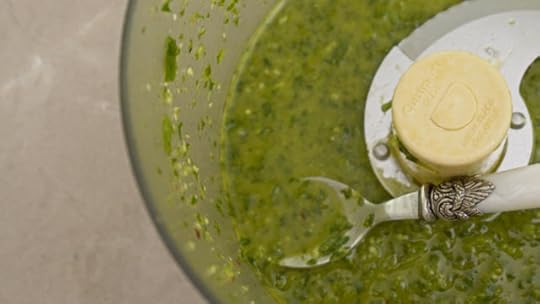
Nutritional Information (per serving):
Calories: 273
Carbs: 2.2 grams
Net Carbs: 2.2 grams
Fat: 28 grams
Protein: 0 grams

The post Primal+Keto Cooking Made Easy: Chimichurri appeared first on Mark's Daily Apple.



June 30, 2019
Primal + Keto Pizza
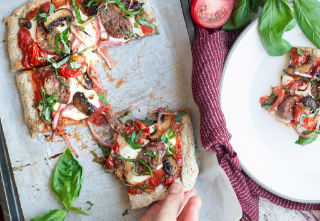 When people say they won’t do keto because they find it too limiting, we shake our heads because it just doesn’t have to be that way. Rich and hearty salads, succulent meats, tender roasted veggies, tempting snacks and desserts—there’s not much you can’t eat on keto if you know how to do it.
When people say they won’t do keto because they find it too limiting, we shake our heads because it just doesn’t have to be that way. Rich and hearty salads, succulent meats, tender roasted veggies, tempting snacks and desserts—there’s not much you can’t eat on keto if you know how to do it.
This fresh and flavorful pizza is proof positive that you don’t need to give up great food (even comfort food!) to enjoy all the health benefits of keto living. We love this recipe for the substantial crust, the creamy cheese, bright tasting sauce and all the amazing toppings. (Hint: make a couple crusts at a time and freeze one between waxed paper in a sealed freezer bag.) Once you try this pizza, you’ll definitely want to make it again!
Ingredients:
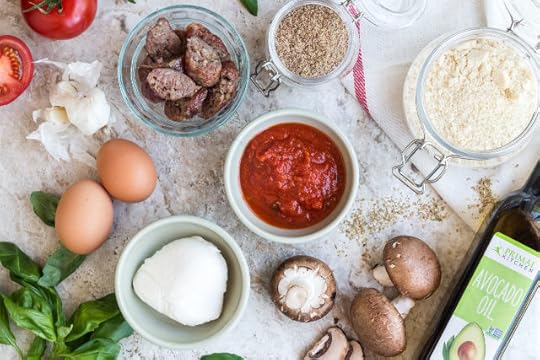
Crust:
1 cup blanched almond flour
4.5 Tbsp. ground flaxseed
2 scoops Primal Kitchen® Collagen Peptides
2 Tbsp. tapioca starch, separated
¼-½ tsp. salt
½ tsp. garlic powder
½ tsp. dried oregano
½ tsp. baking Soda
3 Tbsp. coconut milk
2 Tbsp. olive oil
1 Tbsp. Primal Kitchen Avocado Oil
1 egg
Mushrooms:
1 cup sliced Cremini/button mushrooms
¼ cup sliced red onion
2 Campari tomatoes, quartered
½ Tbsp. olive oil
½ Tbsp. Primal Kitchen Avocado Oil
2 cloves garlic, minced
¼ tsp. dried oregano
Pinch of salt
Toppings:
4 oz. cooked Italian sausage, sliced
4 oz. fresh mozzarella
1/3 cup Raos Marinara Sauce
3 Tbsp. thinly sliced fresh basil
olive oil to brush the crust with
Directions:
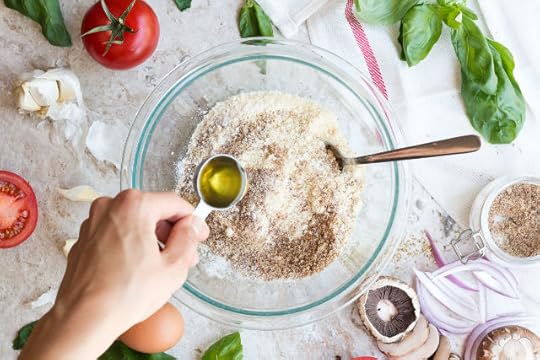
Preheat the oven to 375º degrees. In a bowl, combine the almond flour, flaxseed, collagen and 1 tablespoon of tapioca starch. Stir in the salt, garlic powder, dried oregano and baking soda. Slowly add in the coconut milk, olive oil and avocado oil. Whisk the egg and add it to the dough. Allow the dough to rest for a few minutes.
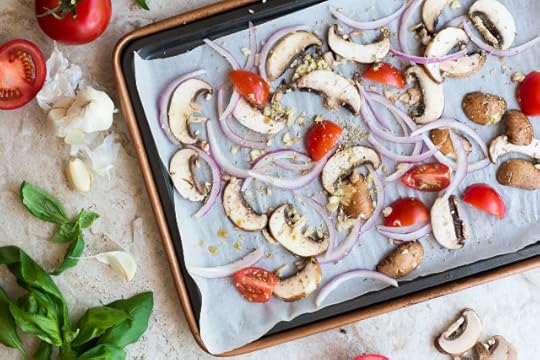
Toss the mushrooms, red onion and campari tomatoes with the olive oil, avocado oil, minced garlic, oregano and salt. Lay the vegetables out on a parchment covered sheet pan and roast for 15-20 minutes, flipping once in between.
Slice the fresh mozzarella into thin slices and place them between two pieces of paper. Allow them to dry out like this for 30 minutes.
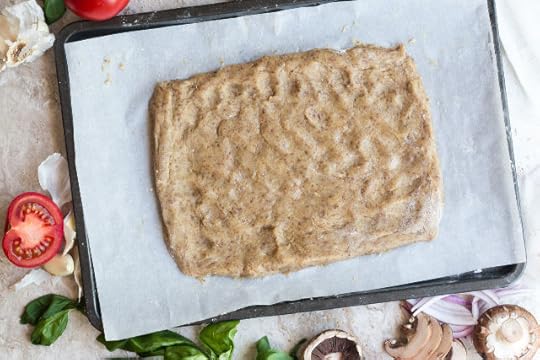
Dust another parchment covered sheet pan with half a tablespoon of tapioca starch. Pour out the dough onto the parchment and spread it out so it is in a rectangular shape. Sprinkle more tapioca starch on the dough and your hands as you work. The dough will be sticky so you can also use a silicone spatula to help you spread. Sprinkle the last of the tapioca starch over the top of the crust and spread it until it’s a rectangular shape around 10”x6”. Bake the pizza for ~10 minutes or until the crust is just set.
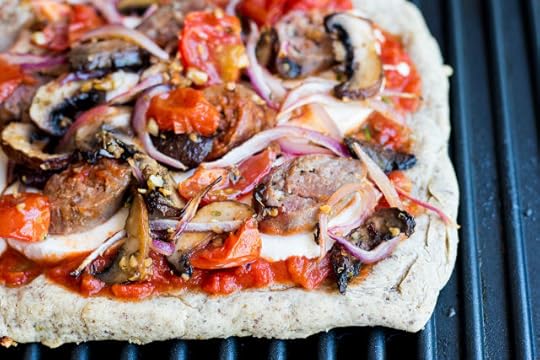
Heat a grill over medium heat. While it is heating, remove the crust from the oven. Spread on the marinara sauce, leaving a small amount of crust around the outside of the pizza. Sprinkle half of the basil all around the sauce. Lightly press the mozzarella slices onto the sauce. Arrange the sausage slices and mushroom mixture on the pizza. Brush a little olive oil on the crust. Carefully move the pizza from the pan to the grill, making sure to place it over indirect heat. Cover the lid and cook for 2-3 minutes, or until the cheese starts to melt slightly and the bottom of the crust is a little browned. Remove the pizza from the grill and garnish with the remaining basil immediately. Cut into 6-8 squares and enjoy!
**This pizza has a dense crust that’s a perfect vehicle for all sorts of topping goodness. The pizza crust is pre-baked and then grilled with the toppings. If you don’t have a grill, you can bake the pizza from start to finish in the oven – prebake the crust as directed and then finish baking at 400 ºF for about 5-7 minutes after you’ve added the toppings. This recipe uses fresh mozzarella which is dried out before baking, but it will get watery on your pizza if you grill it for too long. If you want more of a melted and browned cheese, swap out fresh mozzarella for a block or shredded mozzarella that has moisture already removed.
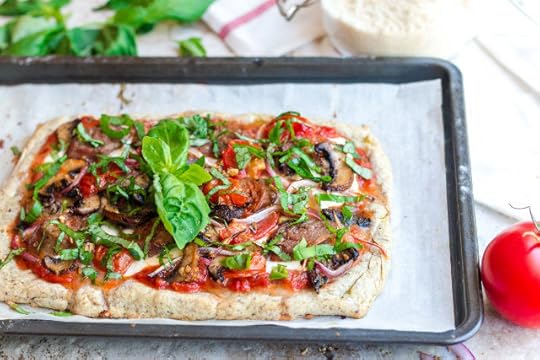
Nutrition Information (1/6 of pizza):
Calories: 367
Total Carbs: 9 grams
Net Carbs: 5 grams
Fat: 29 grams
Protein: 17 grams

The post Primal + Keto Pizza appeared first on Mark's Daily Apple.



Mark Sisson's Blog
- Mark Sisson's profile
- 199 followers



